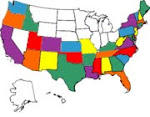The Columbia River begins in the country Canada. The Columbia River drains in seven states: Oregon, Washington, Idaho, Montana, Nevada, Wyoming, and Utah. It flows for more than 1,200 miles, from the base of the Canadian Rockies to the Pacific Ocean at Astoria, Oregon, and Ilwaco, Washington.
The explorers that we are learning about rowed down this river in dug out canoes. Their names were Lewis & Clark. Lewis & Clark explored places in the United States that were not known about yet. We think they might have been very impressed by this river when they saw it too. What do you think?
One of the reasons we like the Columbia River is because it is full of salmon. Remember how we like salmon and Austin tried to catch some? We drove to a dam in the river yesterday so we could see the fish ladder there that lets fish get through. It was interesting.
We learned some facts about the fish in the river. Did you know that when the river reaches 69 degrees, that is too warm for the fish? We love swimming in water that warm. We must be different than fish in that way. We learned about how trash and litter can hurt the fish and how we can help by cleaning litter away when we see it.
We also learned how native trees and dirt are important for the river to stay healthy. Remember how we said the water can't get too warm for the fish? Trees and plants help to keep the water cool so they can live. There is a club called Kids for the Columbia Club that kids can join to help keep this river big and strong.
One more fun thing to know about the Columbia River is that 2.100 ships have shipwrecked at the mouth. When we were in Long Beach, Washinton one of the people that lived there told us about special boat captains they have there to help the boats come in because of all of the shipwrecks. They are the only ones allowed to drive boats there because they know how to do it without wrecking. Isn't that cool?
More Columbia River Fun: Lower Columbia River Kids Website
































